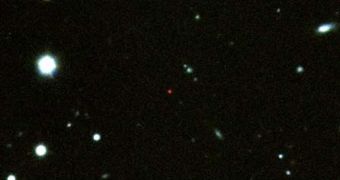NASA's Swift satellite is the first spacecraft to have spotted the first signs from the earliest known explosion in the entire Universe. The phenomenon is believed to have taken place about 13 billion years ago, when the Cosmos was just around 700 million years old. The star that exploded sent forth a massive amount of radiation, in the form of a gamma-ray burst (GRB). It required all this time to reach our planet, and it was first observed on April 23. Usually, these types of emissions become visible when stars collapse into black holes, at the end of their burning cycle, Space reports.
Two astronomy teams then took it upon themselves to establish the distance at which the star exploded from the Earth. The European Southern Observatory (ESO) used its 8.2-meter Very Large Telescope (VLT) facility, located in La Silla, Chile, one of the most suitable places for astronomical observations in the world. The night sky is truly astounding from this location. The second instrument that was used was the Italian Telescopio Nazionale Galileo, a 3.6-meter observatory in Spain. Both the telescopes observed that the new GRB, dubbed GRB 090423, originated some 13 billion light-years away.
For all intents and purposes, this makes the new emission source the most distant ever known. The previous record-holder was a GRB known as GRB 080913, which originated some 12.8 billion light-years away. “We have been looking for a burst like this for several years, so we of course expected that we'd get lucky one day – but it was a 'spine-tingling' moment to realize that this was finally it,” University of Leicester expert Nial Tanvir said. He has been one of the team members that has worked at the ESO facility, in analyzing the traits of the new radiation burst.
“This explosion provides an unprecedented look at an era when the universe was very young and also was undergoing drastic changes. The primal cosmic darkness was being pierced by the light of the first stars and the first galaxies were beginning to form. The star that exploded in this event was a member of one of these earliest generations of stars,” National Radio Astronomy Observatory (NRAO) expert Dale Frail added. The main goal astronomers have now is to look at the time when the primeval darkness started being removed by traces of light, from either growing stars and galaxies, or from explosions.

 14 DAY TRIAL //
14 DAY TRIAL //